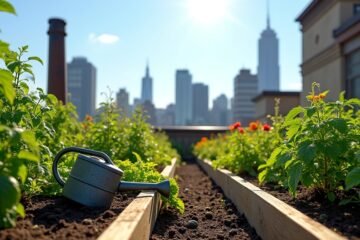Want to turn your compact space into a flourishing garden? Raised beds are your trusty sidekick! They maximize sunshine and create stunning plots. Choose materials like sturdy cedar or charming reclaimed wood for added character. Mix rich compost with well-draining soil to pamper your plants. And hey, with regular watering and pest checks, you’ll be harvesting homegrown veggies before you know it! Stick around, and you’ll discover even more garden secrets to help your oasis thrive!
Benefits of Raised Bed Gardening
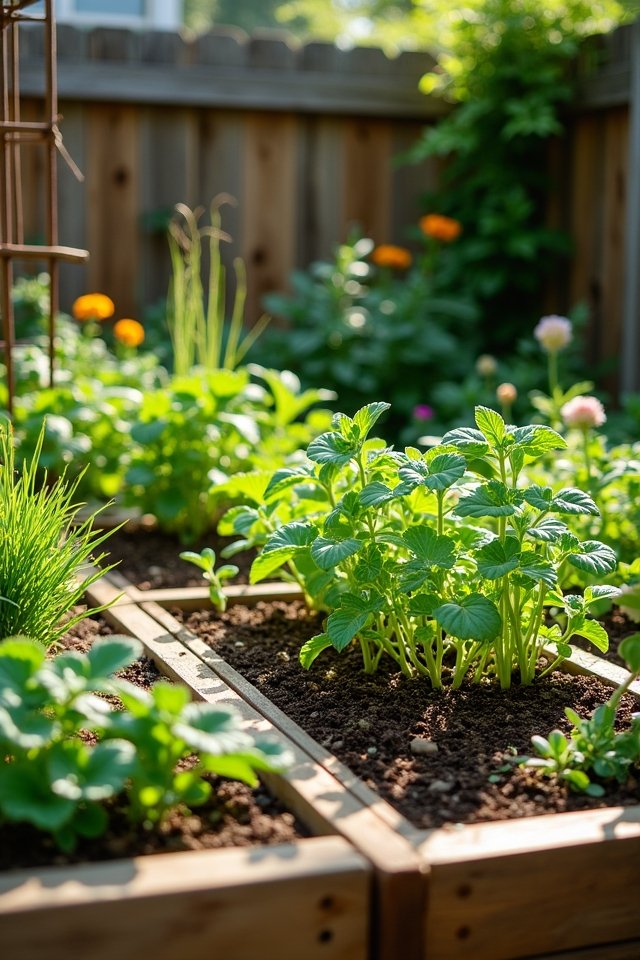
If you’ve ever found yourself wishing for a lush garden amidst your compact space, raised bed gardening is like having your cake and eating it too! These beautifully organized plots not only maximize space efficiency but also create a stunning oasis. Picture vibrant tomatoes, fragrant basil, and crisp lettuce, thriving just a few feet from your door! You’ll discover that raised beds make pest control a breeze, too. Elevated plants can deter pesky critters while allowing easy access for inspection. Plus, you can use innovative materials like reclaimed wood or metal for a unique touch. It’s like turning your urban landscape into a flourishing retreat. So, why wait? Immerse yourself in the delightful world of raised beds and transform your little patch of earth today!
Choosing the Right Location
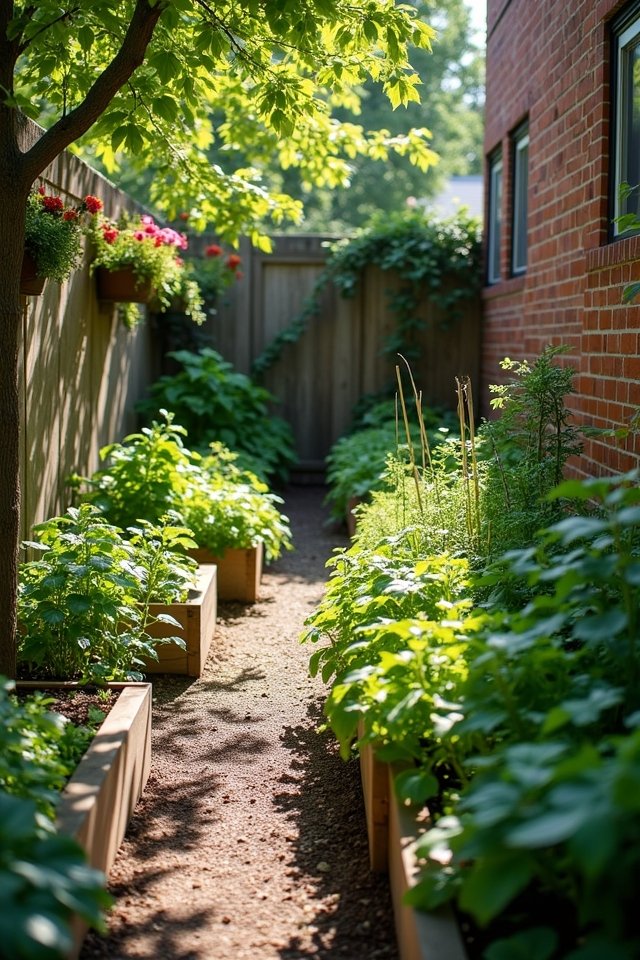
Where’s the best spot to plant your raised beds? Imagine this: a sunny oasis where veggies thrive! You’ll want to focus on maximizing sunlight exposure. Ideally, find a spot that bathes in at least six hours of sun daily. But don’t forget those pesky drainage considerations! If your garden’s swimming instead of thriving, it’ll be a soggy mess. Choose a location with a slight slope or firm ground to avoid waterlogging. A little slope can work wonders, directing excess rain away. Remember, your raised beds are the stars of the show, so give them a stage! With the right sunlight and drainage, you’ll be on your way to a flourishing urban garden that even your neighbors will envy!
Selecting Materials for Your Raised Beds
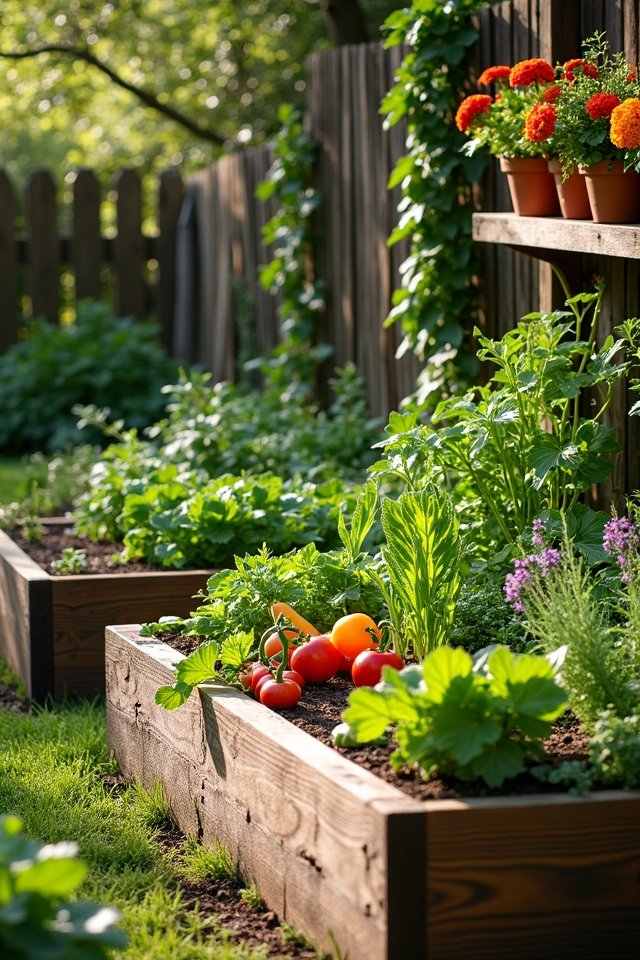
After you’ve found that perfect sunny spot for your raised beds, it’s time to get creative with materials! The choices can be as colorful and varied as a blooming flower garden. Think outside the box with these options:
- Wood options: Cedar or redwood are great for durability and aesthetics.
- Metal choices: Galvanized steel brings modern flair and longevity.
- Recycled pallets: Eco-friendly and charming, they add character!
- Concrete blocks: Sturdy and versatile, perfect for unique designs.
- Bricks: Classic and timeless, they offer a rustic touch.
Choose wisely, and your raised beds will not only be functional but also stunning! Which material speaks to your garden dreams? Let your creativity blossom!
Soil and Nutrient Considerations
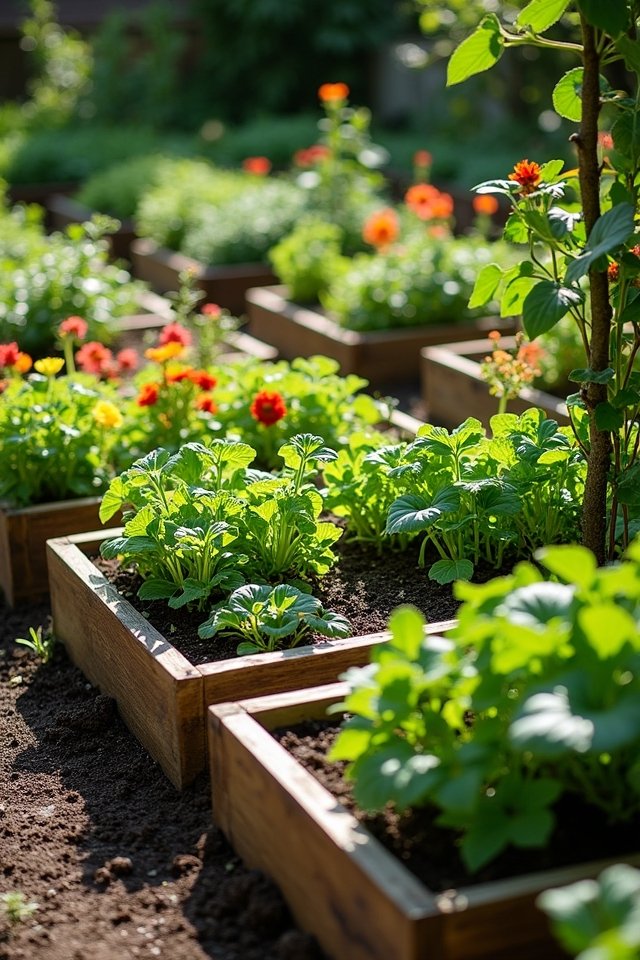
Soil is the heartbeat of your garden, and getting it right is essential! The right soil types can make all the difference in how your plants thrive. You’ll want a rich blend of organic matter, like compost, to boost nutrient management. Think of your garden soil as a gourmet meal—your plants will gobble up those nutrients!
Experiment with a mix of sandy, loamy, and clay soils for the ultimate texture, ensuring good drainage and moisture retention. Don’t forget to test your pH levels, too; it’s like checking the temperature before cooking! By keeping an eye on nutrient levels and amending your soil regularly, you’ll create a vibrant ecosystem that fizzes with life. Happy gardening!
Designing Your Raised Bed Layout
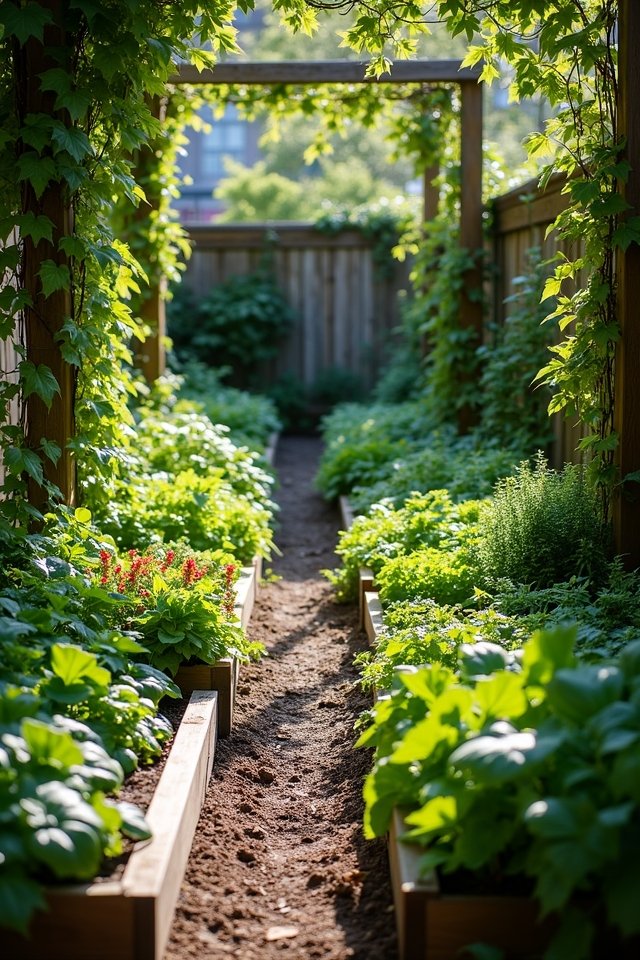
Planning your raised bed layout is like sketching out the blueprint for a cozy home—everything has its perfect place! You want to maximize space while ensuring your plants thrive. Think about your layout patterns and how they’ll shape your garden experience. Here are some innovative tips to get you started:
- Mix height levels: Taller plants behind shorter ones create a beautiful view.
- Group by needs: Place sun-lovers together and shade-seekers in cooler corners.
- Use vertical structures: Trellises add dimension and save space.
- Incorporate paths: Maintain spacing techniques for easy access—don’t get stuck!
- Plan for rotation: Switching crops each season revitalizes nutrient balance.
Get ready to release your creativity and design a garden that dazzles!
Best Plants for Small Raised Gardens
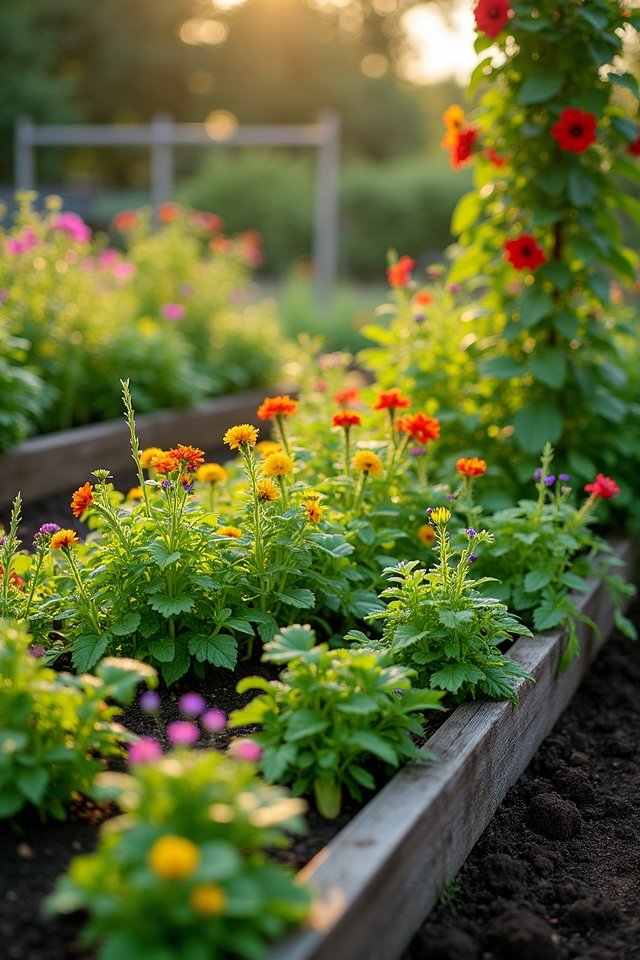
When you’re working with a small raised garden, picking the right plants is like choosing the perfect toppings for a delicious pizza—every choice matters! Opt for compact vegetables like radishes, baby carrots, and bush beans; they thrive in tight spaces. Imagine plucking fresh, vibrant produce right from your yard! If you’re itching to maximize your vertical gardening game, try climbing plants like peas or tomatoes on trellises. Picture those bright red tomatoes trailing up like nature’s own artwork! Don’t forget to sprinkle in herbs like basil and cilantro; they add flavor and charm. Isn’t it exciting to think about your tiny oasis bursting with life? Now, let your creativity flow, and plant your dreams into reality! Gardening magic awaits!
Maintenance Tips for Thriving Beds
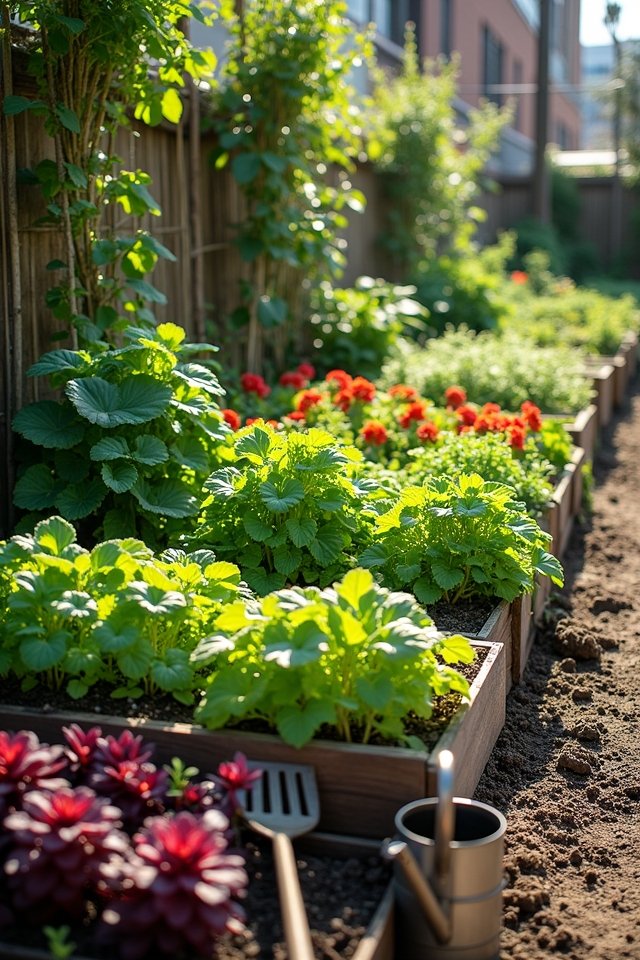
Your small raised beds are thriving, but how do you keep that garden party going strong? With a little love and some savvy maintenance tips, your plants will flourish like never before! Here’s how to keep the excitement alive:
- Regularly check for pests: A quick inspection helps you catch trouble before it multiplies—think of it as garden detective work!
- Rotate your plants seasonally: Just like a well-curated playlist, freshness keeps everything lively.
- Water wisely: Deep, infrequent watering encourages roots to dig deep—like they’re on a treasure hunt!
- Add compost: Nourishment is the secret sauce that keeps your plants raving.
- Stay alert for seasonal changes: Adapt your care routine and watch your garden thrive with the seasons!
Frequently Asked Questions
How Do I Control Pests in My Raised Bed Garden?
To control pests in your garden, you’ve got plenty of natural pest options! Try introducing friendly insects like ladybugs or lacewings, which are nature’s tiny defense squad! You can also sprinkle diatomaceous earth around plants; it’s like a protective armor against creepy crawlers. For an organic solution, mix garlic or hot pepper sprays—pests hate those! Creating healthy soil helps plants resist pests too! Imagine your garden thriving without harsh chemicals; it’s not just a dream!
Can I Use Old Wood for Raised Beds Safely?
You can definitely use old wood for raised beds, but hold on; not all wood’s created equal! If it’s treated with harmful chemicals, you might end up with a garden that’s more toxic than tasty. Look for untreated wood, like cedar or redwood—these beauties resist rot and enhance bed longevity. Plus, they add rustic charm! Just imagine those fresh veggies nestled safely among those weathered planks. Isn’t that a delightful thought?
What Is the Best Height for Raised Garden Beds?
Did you know that raised beds can increase crop yields by up to 20%? For ideal dimensions, a height of 12 to 18 inches works wonders! This depth allows for healthy soil depth, giving roots plenty of room to explore. Imagine your veggies growing tall and proud! Taller beds also ease the strain on your back—no more bending like a pretzel! So, elevate your garden game and watch it thrive like never before!
How Often Should I Water My Raised Beds?
You should water your raised beds about once or twice a week, depending on your climate! Think of it like quenching a thirsty garden’s thirst. If you notice that the soil’s dry like a desert, it’s time to splash some water! But keep an eye on moisture retention—too much can drown your plants. Always check the soil a couple inches down; it’s like giving your garden a little love tap! Happy gardening!
Can I Grow Vegetables Year-Round in Raised Beds?
Absolutely, you can grow vegetables year-round in raised beds! Think of it as having a culinary adventure, where seasonal vegetables like vibrant carrots and crunchy lettuce dance across your plate! With some clever planning, you can cozy those beds up with frost cloths or mini greenhouses during colder months, ensuring your garden’s still thriving. Who wouldn’t enjoy fresh produce in winter? So, grab those seeds, and let’s make your veggie dreams sprout all year long!
